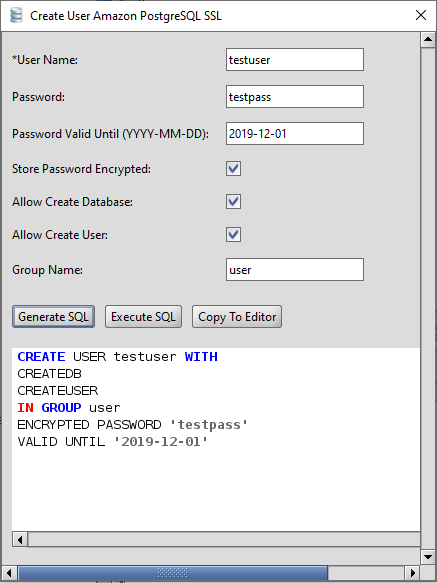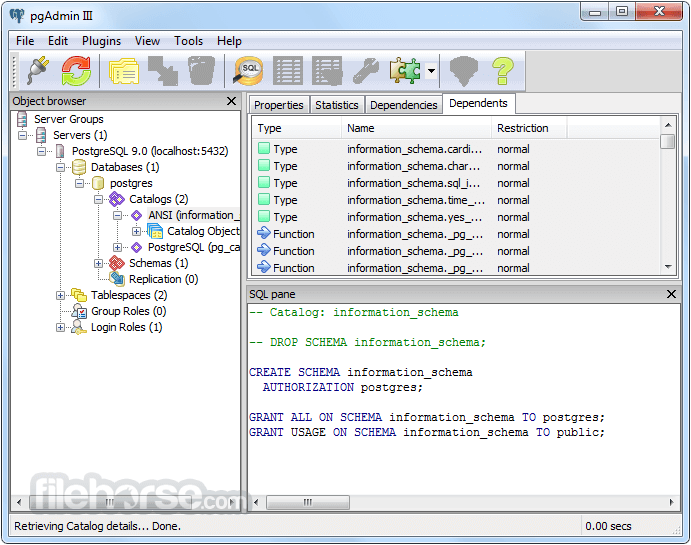Windows x86-64 Interactive Installer Supports: Windows Server 2012 R2, Windows Server 2016, Windows Server 2019. Brew install postgres. Initialize Postgres. This command initializes the database. Initdb /usr/local/var/postgres. Set up Postgres to run at startup. Check if the directory /Library/LaunchAgents exists. Create it if it doesn’t exist. Find the plist file that came with the postgres install. A basic knowledge of database query languages may be needed to get the most from your Mac database tool. Note: There are many different database tools. Also, many people are using databases on their Macs, such as FileMaker Pro, that aren't on this list because the latest version isn't free or open source.
- Postgres Create Database Download For Mac Windows 7
- Postgres Create Database Download For Mac Os
- Postgres Create Database Download For Mac Download
- Postgres Create Database Download For Mac Windows 10
FAQ
Why yet another PostgreSQL GUI client? Why not just pgAdmin?
Well, pgAdmin is great for its feature-richness. However, I found its UI is clumsy and complicated. I know there is a list of PostgreSQL GUI Tools. However, they are either web-based, Java-based* or don't support the features I want. In the good old MySQL world, my favorite client is Sequel Pro, but its support for PostgreSQL doesn't seem to be happening. So, I decided to make one myself.
* No offense to the Java community. I am a Java developer myself and I like JVM a lot. I just dislike Java desktop apps personally.
Is PSequel open source?
No. There is no plan to open source it at this moment.
Is PSequel a forked version of Sequel Pro?
No, PSequel is written from scratch in Swift 2, although PSequel's UI is highly inspired by Sequel Pro.
Why macOS 10.10+ only?
Postgres Create Database Download For Mac Windows 7
I am developing PSequel in my spare time. By supporting macOS 10.10+ only, I can keep the codebase simpler and save time by not testing it in older versions of macOS. And, less code, less bugs.
What's the current status of PSequel?
PSequel is still in its early stage. My plan to implement most features in Sequel Pro. If you think a feature is important, please let me know and I'll adjust its priority based on its popularity.
How do I report bugs or suggest new features?


Use Github issue tracker. Please try not to create duplicate issues. If you are reporting multiple bugs or suggesting multiple features, please create separate issues for each bug/feature. Please include your macOS, PostgreSQL and PSequel versions when reporting a bug. If you don't have a Github account, you could report bugs here.
How do I support the development of PSequel?
If you like PSequel, please report bugs and/or help spread the word.
There are two main ways to install PostgreSQL on mac OS X.
- Downloading the app file from postgresapp.com.
Using Homebrew
Homebrew can be installed by running the following command in a terminal:
/usr/bin/ruby -e '$(curl -fsSL https://raw.githubusercontent.com/Homebrew/install/master/install)'
If Homebrew is already installed, make sure that it is up to date by running:
brew update

Then ensure there are no conflicts or errors using:
brew doctor
Homebrew is a powerful package manager with many uses, including installing and running postgreSQL. This can be done by typing the following command into a terminal:
Now that postgres is installed the default server can be started by running the command:

This will start up a postgres server hosted locally on port 5432. The server will be run out of the directory /usr/local/var/postgres.
It can now be accessed by typing the following command:
This will connect to the server and access the postgres database. Once this is done:
- Schemas and tables can be created
- Data can be loaded and deleted from the database
- Queries can be run
The process should look like this:
This shows that the server has been started and can be connected to.
(Optional) Creating a Custom Data Directory
A custom data directory can also be used for a server. To do this, first create a directory to be used as the server location. For example, create a directory called myData in the home directory:
Postgres Create Database Download For Mac Os
Once the directory is created, the server can be initialized. This means that we configure the directory and add the necessary files to run the server. To do this run the initdb command as shown:
This will fill the myData directory with files necessary to run the server:
Now that the server is initialized and the log file is created, you can start the server from this directory. To do this use the command and substitute in for the specified values:
Postgres Create Database Download For Mac Download
How to provide great customer support with content. The “Data Directory” refers to the directory that was just initialized (in this case myData). The “Log file” is a file that will record server events for later analysis. Generally log files are formatted to contain the date in the file name (e.g. “2018-05-27.log” or “myData-logfile-2018-05-27.log”) and should be stored outside of the database that they are logging so as to avoid unnecessary risks. Log files can be dense to read but are very useful for security and debugging purposes:
The command above will generate a log file like the one shown, start the server, and tie the log file to the server. If a log file is not specified, events will be logged to the terminal:
The server will only start if the port is free. If the default server is running it must first be stopped using the pg_ctl -D /usr/local/var/postgres stop command:
Once started, it can be connected to the same way as before using:
Using PostgreSQL App
To run a server through the postgres app, the first step is to download the program. The app can be downloaded on postgresapp.com. Once the app is downloaded and moved into the applications folder, the app can be opened.

Open the Postgres app:
In order to start the server, click the start button.
This will start the server. Details on the server can be found by opening the server settings:
This interface shows all the essential information regarding the server. It also allows the port to be changed very easily. This is useful because multiple PostgreSQL servers can
Note: To change the port in the terminal, the ‘postgres.conf’ file (which can be found in the data directory) must be edited. This looks like the following:
Using Terminal with the PostgreSQL App
Postgres Create Database Download For Mac Windows 10
Once the app has been downloaded, command line tools can be used as well. These tools can be accessed by typing:
For example, the ‘postgres’ database on the server can be connected to using the psql tool with postgres as an argument:
Rather than typing out the full path each time however, the path can be added to a file that will allow significantly easier access to the tools, allowing the tools be accessed from any directory on the computer. To do this, the following command can be run in the terminal:
Once this is done, the ‘postgres’ database can be accessed by simply typing:
Summary
- Homebrew:
- Download/update Homebrew
- Use Homebrew to install postgres
- (Optional) Create New Data Directory
initdb
- Start Server
- App:
- Download app and move to Applications
- Run App
- (Optional) Set different port for multiple servers
- Start Server
- (Optional) Add path so that command line tools are easy to access
References
Written by: Matthew Layne
Reviewed by: Blake Barnhill , Matt David


